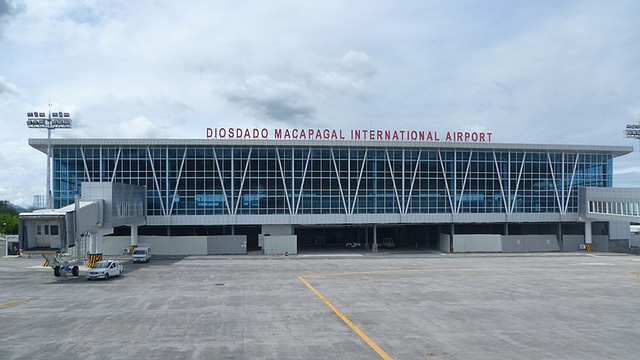SUMMARY
This is AI generated summarization, which may have errors. For context, always refer to the full article.

MANILA, Philippines – For the Clark Airport and Clark Economic Zone in Pampanga to flourish, major roads leading to them must be adapted to climate change.
This was one of the conclusions made by a study that assessed how prepared Angeles City in Pampanga is for the effects of climate change. The shifting climate can lead to stronger storms, extreme droughts, increased rainfall, flooding and landslides.
The city co-hosts the economic zone and airport along with the towns Mabalacat and Porac.
The Central Luzon city was one of 4 evaluated by the study conducted by World Wide Fund for Nature (WWF) Philippines and BPI Foundation.
It gave Angeles City a score of 5.56, the lowest vulnerability rating among the 4 cities. But the urban hub still faces many threats from climate change.
The score was given based on 3 factors that determine how climate-vulnerable a city is: climate or environmental exposure, socio-economic sensitivity, and capacity to adapt.
Climate or environmental exposure
Being situated inland and far from the sea and being 90 meters above sea level allows Angeles City to enjoy protection from storm surges and sea level rise, another impact of climate change.
However, its proximity to Abacan River, which flows through Pampanga, exposes it to flooding when the river overflows. Increasing amount of rainfall brought about by changes in climate will make this more likely.
Already, annual rainfall has risen by 46% in 13 years, from around 1,600 mm in 1998 to more than 2,400 mm in 2011. This is because the southwest monsoon has intensified, spawning more rain and ultimately, more flooding.
Angeles City is hit by an average of two typhoons year. Because of the shifting climate, these typhoons are likely to get stronger and more frequent.
Socio-economic sensitivity
The city’s population is growing and there are now more people occupying the city’s small land area. In over 20 years, population rose from 230,000 in 1990 to 326,000 in 2010 – a growth of 38%.
Because of this, Angeles is now among the cities with the highest population densities assessed by the study. There are now 5,249 people per square kilometer. Angeles logged the highest population figures among the 4 cities evaluated.
Angeles City also has lots of cars, congesting the city even more. The number of registered vehicles more than quadrupled in the past 20 years. In 2012, there were 85,475 cars in the city.
Clearly, locals value personal mobility despite bumper-to-bumper traffic spawned by a combination of booming population and lack of efficient mass transportation.
Clark International Airport is also logging in more passengers. From 2005 to 2012, its number of passengers more than quadrupled from 230,000 to more than 1.3 million.
Foreign trade exports in the city grew 10 times in 7 years, bringing in US$3.6 billion in 2012 up from around $210 million in 2005.
Adaptive capacity
Because of its growing economy, the people of Angeles City have enough financial resources to recover from effects of climate change.
Annual family savings rose from around P14,000 to P32,000 from 1991 to 2009. The increasing number of bank accounts in the city corroborate this – from 240,202 in 2007 to more than 357,000 in 2012.
The city government itself is also enjoys good financial reserves. Over 9 years, city savings doubled from around P84 million in 2003 to P160 million in 2011.
Pampanga province as a whole benefits from impressive human capital. By 2008, functional literacy (ability to read and write) was at 92.1% up from 87.3% in 1994. Functional literacy increases a person’s ability to bounce back after disasters and climate change impacts.
Recommendations
For Angeles City to continue to prosper, it must ensure all-weather access to major roads that link it to the different parts of Luzon.
Its main source of economic growth – the Clark Economic Zone and airport – serves Metro Manila and other parts of the region through the North Luzon Expressway. But NLEX has experienced flooding in previous storms and will likely experience more unless something is done to climate-proof it.
The same can be said of the Subic-Clar-Tarlac Expressway which feeds into the NLEX at the Angeles-Clark junction.
Disrupted access due to the flooding of these major roads can endanger the viability of the economic zone and airport, thereby crippling a big part of Angeles City’s economy.
Climate-proofing these roads and improving access opens up more opportunities for Angeles City and Clark. With access assured at all times, the Clark Airport can be developed as a better alternative to Metro Manila’s smaller and older airport.
It is Luzon’s largest air facility with over 2,400 hectares and vast expansion potential. In comparison, the Ninoy Aquino International Airport covers only 600 hectares and already suffers from a negative profile.
Already, the government has plans to construct a new budget terminal in the airport starting second quarter of 2014.
Developing Clark Airport will provide millions of air passengers a fresh alternative and economic benefits for Angeles City and surrounding cities.
But Angeles City’s dependence on this single economic generator makes it even more vulnerable to climate change impacts. It should consider creating more sources of income so that if the economic zone can no longer bring in money, it will have alternatives.
***
Angeles City is one of 4 cities assessed by the study. The others are Tacloban City in Leyte, Naga City in Camarines Sur, and Batangas City in Batangas. Previous phases assessed 8 other cities. Download the studies for all 12 cities from this site. – Rappler.com
Add a comment
How does this make you feel?
There are no comments yet. Add your comment to start the conversation.